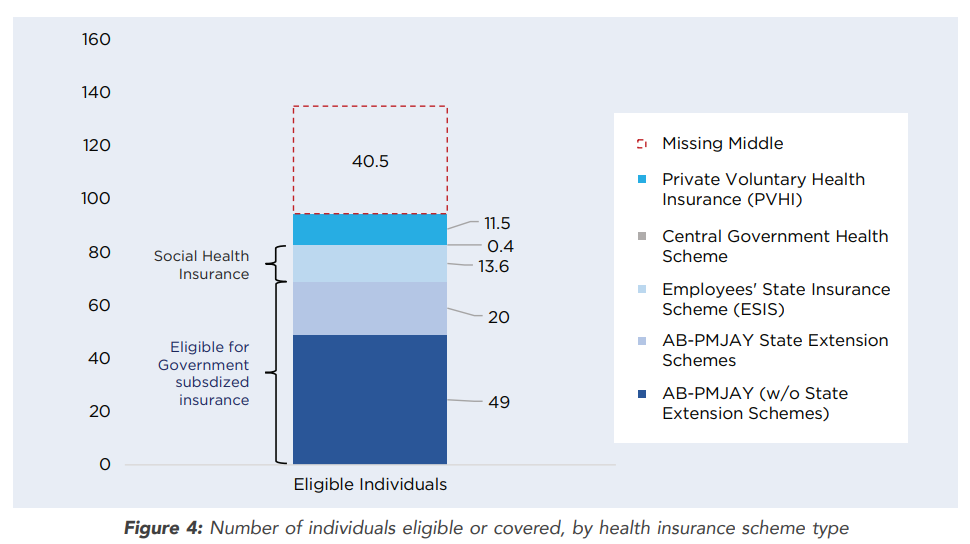[ad_1]

Introduction:
Healthcare has taken centre stage across the globe after the outbreak of COVID-19 pandemic.
The central government has increased investment in health infrastructure to strengthen the sector and facilitate increased access to healthcare facilities.
Both centre and state governments have increased their emphasis on boosting healthcare research and establishment of advanced and hi-tech health care facilities and laboratories.
Overall, there has been an 82% increase in the outlay for the health sector as per Union Budget 2021 in comparison to the previous budget.
The funds for the health and family welfare have been increased to Rs 71,268.77 crores in 2021-22 and to Rs 2,663 crores for health research.
Context:
Recently, Rajasthan began the registration for an insurance scheme under which each family in the state can claim up to ₹5 lakh every year for medical expenses.
The State began the registration for Chiranjeevi Health Insurance Scheme, announced by Chief Minister in the state budget 2021-22.
Rajasthan has become the first state in the country, where each family will get health insurance of ₹5 lakh each year. People can get registered and be assured of cashless treatment.
Chief Minister of Rajasthan said the registrations for the government’s cashless treatment for all have begun in the state from today.
It is one of our biggest health care schemes aimed at providing medical relief to all residents of Rajasthan.
Health Insurance / Assurance in India: Need and Landscape:
- Expansion of health insurance / assurance coverage is a necessary step, and a pathway in India’s effort to achieve Universal Health Coverage (UHC).
- Low Government expenditure on health has constrained the capacity and quality of healthcare services in the public sector.
- It diverts majority of individuals – about two-thirds – to seek treatment in the costlier private sector. However, low financial protection leads to high out-of-pocket expenditure (OOPE).
- India’s population is vulnerable to catastrophic spending, and impoverishment from expensive trips to hospitals and other health facilities.
- The catastrophic effect of healthcare spending is not limited to the poor – it impacts all segments of the population.
- Pre-payment through health insurance emerges as an important tool for risk-pooling and safeguarding against catastrophic (and often impoverishing) expenditure from health shocks.
- Finally, pre-paid pooled funds can also improve the efficiency of healthcare provision.
Innovation Fund for development work:
- The State government also said that it will provide funds to each district for work related to public utility asset creation as per the local needs from the Chief Minister’s Innovation Fund.
- Rajasthan state government has approved the Chief Minister’s District Innovation Fund Scheme for development in accordance with local needs of each district of the state.
- In this state-funded scheme, each district will be allocated ₹1 crore per year.
- The main objective of the scheme is to create employment opportunities by sanctioning work related to creation of public utility assets, incorporating their innovations in accordance with the local needs and public aspirations of the district as experienced by the district collector.
- The Rural Development department will be the nodal department of the scheme at the state level, and the Zila Parishad at the district level will be the nodal agency for approval and implementation.
- Approval of projects for the amount available in this scheme will be issued by the district collector.
NITI Aayog Releases Report on ‘Health Insurance for India’s Missing Middle’:
NITI Aayog released a comprehensive report titled Health Insurance for India’s Missing Middle, which brings out the gaps in the health insurance coverage across the Indian population and offers solutions to address the situation.
The report highlights the need for designing a low-cost comprehensive health insurance product for the missing middle.
It primarily recognizes the policy issue of low financial protection for health for the missing middle segment and highlights health insurance as a potential pathway in addressing that.
In doing so, the report offers a starting point for broader discussions on solutions, and specific products, to improve insurance coverage for the missing middle.
The report proposes wider industry and government stakeholder consultations, and discussion with consumer groups to delve deeper into the specifics of the problem, and potential solutions.
Suggestions:
The experience of Thailand, China, and Latin American countries offers two lessons.
- First, they demonstrate the difficulty of increasing coverage in the informal / unorganised sector.
- Thailand achieved UHC by fully subsidizing the informal sector while China has partially subsidized that segment.
- However, China’s experience indicates the possibility of sustained coverage through a contributory and voluntary scheme.
- Second, the examples from Latin America highlight that adverse selection and inadequate risk-pooling is a pressing challenge for voluntary contributory schemes targeted towards the informal sector.
Therefore, Government should build consumer confidence through swift grievance redressal mechanisms, and robust auditing procedures.
Ensuring quality of health services will improve patient satisfaction and build confidence in health insurance as product.
Such mechanisms ensure that the intended benefits of health insurance – reduction in catastrophic spending and improved access to quality health – are achieved.
They can lead to a virtuous cycle of trust where satisfied health insurance customers recommend it to other, thereby increasing the size of the risk pool.
Conclusion:
Health and Economy have a direct correlation. As the economy of a country improves, the health of its citizens improves and vice-versa.
Despite being one of the fastest growing economies of the world, India’s public healthcare system is in a state of crisis.
But health also presents a challenge for countries, especially those with a vast population like India’s.
Thus, for any country to progress, it’s important that its citizens remain healthy, live longer and are more productive.
[ad_2]

